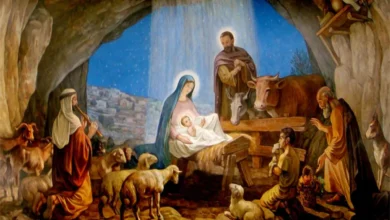The lamb of God who takes away the sin of the world: who is he?
The lamb of God who takes away the sin of the world It is one of the most emblematic concepts in sacred scriptures, especially in Judeo-Christian traditions. It encapsulates a deep theological understanding of redemption and sacrifice.
In this text, we will understand this intriguing phrase, its origins and meanings, answering frequently asked questions to better understand its biblical context and spiritual implications.
Read with us and find out more about the lamb of God who takes away the sin of the world, let's go!
What is “the lamb of God who takes away the sin of the world”?
The phrase “the lamb of God who takes away the sin of the world” is a statement made by John the Baptist when he saw Jesus Christ approaching.
These words are found in the Gospel of John, in the New Testament of the Bible (John 1:29). In this passage, John the Baptist presents Jesus as the supreme sacrifice and Redeemer of humanity.
This powerful metaphor has deep roots in Jewish tradition, where the lamb was an essential part of sacrificial rituals.
The figure of the lamb dates back to Old testment, especially when book of Exodus, where the blood of a lamb was used to mark the doors of the Israelites during the last plague in Egypt.
The lamb, in this context, represented innocence and served as a substitute to protect the families of the Israelites. Likewise, Jesus is symbolized as the lamb of God, offering himself as a pure and unblemished sacrifice to redeem humanity from its sins.
This phrase also encapsulates Jesus' mission on Earth. He came to lift the burden of sin that weighs on humanity, offering the opportunity for forgiveness and reconciliation with God.
The idea is that, through faith in Jesus as the Lamb of God, human beings can be freed from the power of sin and find eternal salvation.
Furthermore, this metaphor highlights the loving and compassionate nature of God. Instead of demanding continual sacrifices, God sent His own Son as the perfect sacrifice, demonstrating His mercy and unconditional grace.
Thus, “the lamb of God who takes away the sin of the world” represents not only a historical event, but an eternal symbol of hope, forgiveness and redemption for all who believe.
Common questions
1. What does lamb mean in the Bible?
In the Bible, the lamb is a symbol of innocence and sacrifice. It is often associated with atonement rituals and represents the perfect offering to God.
The lamb is mentioned in several parts of scripture, symbolizing Jesus Christ, the “Lamb of God”, whose sacrifice is seen as the ultimate redemption for the sins of the world.
2. What is the difference between lamb and ram in the Bible?
Although lamb and ram refer to sheep, in the Bible, “lamb” usually refers to a young, innocent animal, while “ram” refers to an adult animal. The choice to sacrifice a lamb rather than a ram symbolizes purity and voluntary sacrifice, as seen in the sacrifice of Jesus Christ.
3. Where does the Bible say about the blood of the lamb?
Reference to the blood of the lamb is found in the Old Testament, especially during the celebration of the Jewish Passover.
In Exodus, for example, the blood of the sacrificed lamb is used to mark the doors of the Israelites, protecting them from the tenth plague sent by God to Egypt. This practice is seen as a prefigurement of the sacrifice of Jesus Christ, whose blood is considered redemption for the sins of humanity.
4. What does the wolf in sheep's clothing mean?
The expression “wolf in sheep's clothing” is a metaphor used by Jesus to describe false and deceptive people who present themselves as harmless but who, in reality, have malicious intentions.
This image is a warning against hypocrisy and falsehood, highlighting the importance of sincerity and truth in faith and human relationships.

Conclusion
Therefore, the figure of “the lamb of God who takes away the sin of the world” is a powerful symbol of redemption and sacrifice in Judeo-Christian traditions. It represents the divine offer of forgiveness and salvation, offering hope to souls seeking spiritual reconciliation.
By understanding the deeper meaning behind these words, we are invited to reflect on divine grace and the moral responsibility that comes with it. Did you understand better about the subject? We hope so. To the next!




